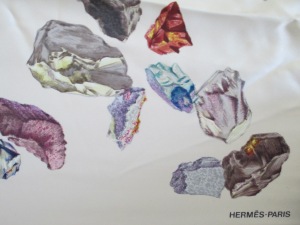
These images are of two Hermès of Paris scarves that were gifts to me. Their original owner was a life-long friend who felt that an outfit just wasn’t complete without a beautiful scarf. I remember her being especially elegant and sophisticated when wearing one of her gorgeous, purchased-in-Paris silk scarves. Four years ago, my darling friend died at too early of an age. I was deeply touched when her sister wanted me to have two of her Hermès of Paris scarves. When I wore one for the first time, I finally understood the special effect of an Hermès. Isn’t that the same effect we want our apparel to have on customers?
How does ICONIC happen?
How does a screen printer’s work become iconic like the house of Hermès? Is it by using many screens similar to the 47 screens that go into printing each Hermès scarf? Or is it like the 11 stages of silk screen printing that Hermès screen printers go through to create the perfect art? Or is it just the original design? Or…. is it similar to the “Tipping Point” (by Malcolm Gladwell) when he shares the story of Hush Puppies shoes that were suddenly “discovered” by a younger generation that helped the company return from a downward slide (I hope I’m remembering that correctly; BTW – great book for anyone in business).
So, how do screen printer’s creations get discovered? One way is to think impulse buy. Pierre-Alexis Dumas, the artistic director of Hermès International and the great-great-great grandson of Hermès creator Thierry Hermes shared the story about the time he saw a long-haired young man with roller blades buy a twilly, a small silk band scarf in the Paris Hermes store because he needed to hold his hair back. What a opportune moment for Hermès and the next group of potentially young consumers seeking out silk bands by Hermes! Talk about on a whim purchase helping to tip the scales in a new direction!
I think there’s much that those of us in the screen printing industry can learn from Hermès of Paris; about creating something that’s timeless with perfect technique that offers perfect art (think: vintage Rolling Stones T-shirt). And, a pathway to a very different status with apparel that appeals to the “impulse”.
Think Star-Power
Just like the screen printers who send their original printed designs to their favorite musicians or to American Idol contestants and then spot them wearing their shirts in local and national venues and in the media, be proactive. When Grace Kelly was spotted in a Hermès of Paris scarf, you already know what that did to help make Hermès accessible and symbolic of beauty and class.
Here are a few thoughts: Retire a bestselling piece and then give it new life after sufficient hiatus. Add a touch of an unexpected color in the design. Give it a vintage edge. Print it on a more form fitting, athletic-type shirt that does away with the baggy effect. Print on DARK. And, make it into a t-shirt dress that is always timely. Use an Icat or exotic motif. Make your creations accessible to impulse buyers. And, get your art out on social media. And, remember, there is not just one type of customer. They are all ages and sizes.
Learn from Hermès.
I learned the history of the Hermès of Paris printing technique after stumbling upon a few articles written by Allison Carey, The Plain Dealer. She detailed an event in 2013 hosted by The Cleveland Museum of Art and Cuffs Custom Clothing of Chagrin Falls that featured Hermes of Paris and two printers from the Hermès Ateliers in Lyon, France, who were invited to demonstrate the secrets of printing the company’s iconic scarves. I’m grateful to Ms. Carey for the information. Please read her articles Here and Here.
The tradition of Hermès began in 1937 when Robert Dumas created the first scarf or carres. It continues with Dumas who says that Hermès are image-makers; that “my family is obsessed. We are dreamers. Human relations are very important, and the desire to achieve a form of excellence is very strong. Whatever you do, you have to do it with your heart and as best as possible. I think the small company started to attract people who share the same values and Hermès became a very special place.”
Is this what you wish to achieve in your small business, as well? Do you share these values with your customers? Do you put your heart and soul into everything you produce? What about your printing technique? Dumas relates that although the process has changed since 1937, art is unable to be separated from tools. “All artists love their tools. They love their brushes, their little tricks, their recipes and techniques. Artists are inventors and innovators…” . Do you love your tools; your printing press, the squeegees that should be in top form to lay the ink onto your substrate? Do you have a perfect set-up? Are your screen cleaning products eco-sensitive (think RhinoTech environmentally-sensitive screen cleaning products) and perfect for the job at hand? Do the final results of everything you do in your work reflect your best creative efforts? Do you embrace new tools and technology like Dumas who offered that though his company has employed the same master screen printers for decades, they explore all new digital and other technologies to ensure that the art that results is true?
We want you to be iconic and hope we can help. Thanks for reading.
Shelley Markus, Marketing Director/RhinoTech